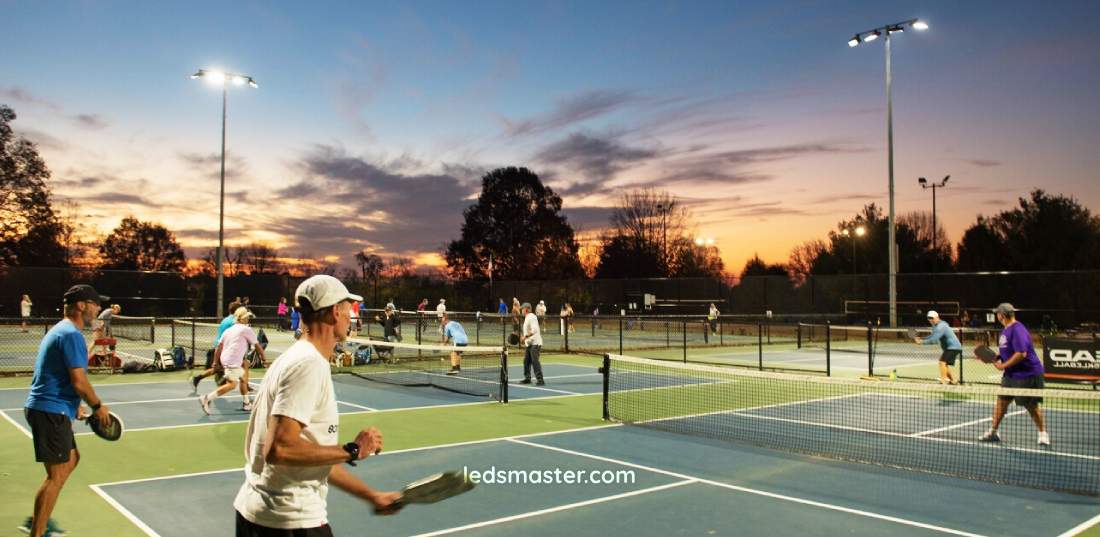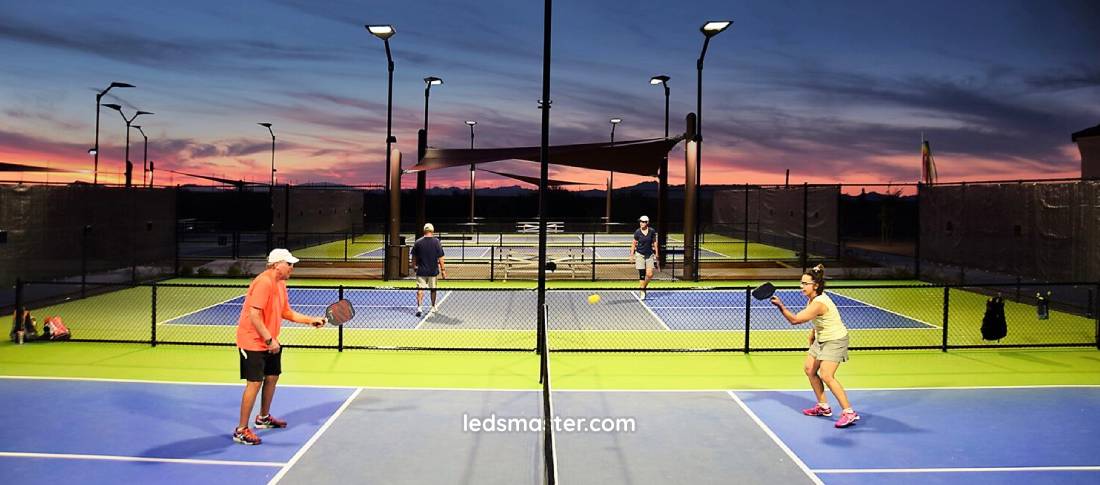Illuminate your pickleball court with precision and efficiency using our advanced LED lighting solutions. Designed for optimal visibility and durability, our fixtures ensure consistent brightness and reduced glare, enhancing gameplay day or night.
Pickleball has gained popularity worldwide, necessitating efficient and effective lighting solutions for both recreational and competitive play. Proper lighting not only enhances visibility but also ensures player safety and enjoyment during evening matches.
Get your complimentary lighting design today
Table of Contents
ToggleIt is not just about visibility but also about ensuring that the players can accurately track the ball’s movement while minimizing glare and shadows. A well-lit pickleball court enhances the comfort of the players, allowing games to extend into the evening hours without sacrificing performance. Thoughtful lighting design also plays a part in creating a pleasant atmosphere for spectators and ensuring that the surrounding environment remains free from unnecessary light pollution.

The foundation of effective pickleball court lighting lies in the careful planning of the lighting design. The goal is to provide consistent illumination across the court, while controlling glare and minimizing shadows.
Uniformity refers to the even distribution of light across the entire playing surface. A well-designed system should prevent patches of overly bright or dark areas that could interfere with a player’s ability to follow the ball or anticipate the opponent’s moves. Consistent lighting across the court ensures that the ball is visible from all angles, enabling players to react appropriately.
Shadows on the court can create areas where the ball is difficult to see, which could negatively affect the fairness of the game. A key goal of pickleball court lighting is to reduce the impact of shadows cast by players or other objects on the court. To achieve this, the positioning and orientation of the light fixtures must be carefully planned. Properly placed lights can minimize the effect of shadows, ensuring that players have an unobstructed view of the ball at all times.
In a competitive match, the ability to judge the trajectory and speed of the ball is vital. This means that the lighting must remain consistent throughout the game, without sudden changes in brightness that could throw off a player’s timing or footing. Consistent visibility is also a safety concern, as sudden transitions in lighting intensity could cause players to trip or misjudge their movements. By maintaining a stable level of illumination, players can move confidently and play at their best.
Glare, which occurs when a light source is too bright or poorly directed, can lead to discomfort and impair a player’s ability to see clearly. For both players and spectators, glare control is an important aspect of the lighting design. Fixtures with appropriate shielding can help direct the light where it is needed—onto the court—without allowing excessive brightness to reach the eyes of the players or audience. The use of carefully selected optics and shielding techniques can significantly reduce the risk of glare, enhancing both the comfort and safety of everyone involved.
The layout of light fixtures on a pickleball court needs to be planned in a way that provides even coverage across the entire playing surface. Each area of the court should receive a consistent amount of light without areas of excessive brightness or darkness. This can be achieved by carefully considering fixture placement, beam angle, and mounting height. Properly oriented light fixtures can ensure that every part of the court is illuminated evenly, improving the overall quality of play.
Fixtures mounted too low may cause excessive glare, while those positioned too high could result in uneven illumination or wasted light. The optimal height for most pickleball court lights is between 20 to 30 feet above the court surface. This height range provides adequate coverage while reducing the likelihood of glare and uneven lighting.
The angle of the fixtures should also be adjusted to focus the light on the playing surface, avoiding light spillage beyond the court boundaries. This ensures that the court is well lit, while surrounding areas, such as spectator seating or nearby properties, are not disturbed by unwanted light.
Another aspect of light distribution is the beam spread of the fixtures. Beam spread refers to how wide or narrow the light is distributed from a fixture. Fixtures with narrower beam angles can focus the light directly onto the playing surface, while wider beam angles may be used to cover larger areas, such as seating areas for spectators or walkways around the court. By adjusting the beam spread, lighting designers can control the coverage of the light and ensure that all necessary areas are illuminated without wasting energy.
To achieve full coverage of the court, lighting fixtures must be positioned not only along the perimeter but sometimes within the court boundaries as well. This strategy ensures that every part of the court receives adequate illumination, enhancing both the gameplay and the overall aesthetics of the facility. Good lighting design also contributes to safety by reducing areas of low visibility where players might trip or collide.
By maximizing the coverage of light across the entire court, the designer can create a lighting system that enhances the visual experience for players and spectators alike. A well-lit court also contributes to the enjoyment of the game by allowing players to focus on their performance without being distracted by lighting issues.
As pickleball courts are often located in residential or community settings, minimizing light pollution is an important consideration in the lighting design. Light pollution occurs when excessive light spills beyond the boundaries of the intended area, causing glare or disturbance to the surrounding environment. This can affect the visibility of the night sky, disturb wildlife, or create unnecessary light in neighboring properties.
Careful planning of the lighting fixtures can help reduce light spillage and ensure compliance with local lighting ordinances. The use of shields and directional lighting can help direct the light downward onto the court surface, minimizing the amount of light that escapes into the surrounding area. In addition to preserving dark skies, reducing light pollution also ensures that energy is used efficiently.
| Aspect | Details |
|---|---|
| Measurement | Lighting level measured in lux (lx) |
| Recreational Play | Minimum average of 200 lux recommended |
| Tournament Play | Lighting level may need to reach 500 lux for optimal visibility |
| Factors Affecting Lighting | Size and layout of the court, type of fixtures used, specific player requirements |
| Court Dimensions | Standard size: 20 feet wide x 44 feet long (for both singles and doubles) |
| Number of Lights | Typically 8 to 12 LED fixtures for outdoor courts; fewer may be needed indoors |
| Lighting Planning | Careful calculation and placement ensure even illumination and energy efficiency |
The level of lighting required for a pickleball court is measured in lux (lx), which refers to the amount of light that reaches a specific surface area. Different levels of play, such as recreational or tournament play, may require varying lux levels to ensure optimal visibility. For recreational play, a minimum average of 200 lux is generally recommended. However, for tournament-level play or competitive matches, the lighting level may need to be as high as 500 lux to ensure that players can see the ball clearly under all conditions.
The lighting needs for a pickleball court depend on several factors, including the size and layout of the court, the type of fixtures used, and the specific requirements of the players and facility. Properly calculating the lighting requirements ensures that the court is evenly lit and that the lighting system is energy-efficient.
Pickleball courts are smaller than tennis courts, with standard dimensions of 20 feet wide by 44 feet long. These dimensions are the same for both singles and doubles play. Understanding the court layout is an essential part of planning the lighting design, as it helps determine the placement and number of light fixtures needed to achieve even coverage.
The smaller size of a pickleball court means that fewer fixtures are needed compared to larger sports courts. However, careful consideration of fixture placement is still required to ensure that the entire playing surface is well lit without areas of uneven illumination.
The number of lights required to illuminate a pickleball court depends on the type of light fixture, the beam angle, and the height at which the fixtures are mounted. For outdoor courts, a typical setup might include 8 to 12 LED fixtures with appropriate wattage and beam spread to cover the playing area effectively. Indoor courts may require fewer fixtures, depending on the size and layout of the facility.
Proper planning and calculation of lighting needs can ensure that the court is evenly illuminated while maintaining energy efficiency.

The choice of light fixtures is another key factor in achieving effective lighting for pickleball courts. Advances in lighting technology have made LED lights the preferred choice for many sports facilities, including pickleball courts.
LED lighting offers numerous benefits for pickleball courts. One of the primary advantages is energy efficiency. LEDs use less energy than traditional lighting options such as halogen or metal halide lights, resulting in lower energy costs over time. LEDs also have a longer lifespan, reducing the need for frequent replacement and maintenance.
Another advantage of LED lights is their ability to provide uniform illumination. LEDs can be designed with adjustable brightness levels and beam angles, allowing for precise control over the distribution of light. This ensures that the entire court is evenly lit, without areas of excessive brightness or darkness.
Fixtures with a high IP (Ingress Protection) rating are essential for protecting against dust, moisture, and other environmental factors. This ensures that the fixtures can withstand outdoor conditions and continue to function reliably over time.
In addition to durability, the design of the fixtures should allow for easy installation and adjustment. Fixtures with adjustable mounting options make it easier to aim the light in the desired direction and ensure that the entire court is properly illuminated. This flexibility is especially useful for outdoor courts where wind or other environmental factors might affect the positioning of the lights.
Careful planning of the mounting height, placement, and power supply can ensure that the lighting system performs optimally and meets the needs of the players and facility.
The height at which the light fixtures are mounted affects both the distribution of light and the amount of glare that players experience. For pickleball courts, lights are typically positioned between 20 and 30 feet above the court surface. This height provides adequate coverage while minimizing glare and shadows. The fixtures should be evenly spaced around the perimeter of the court to ensure that the light is distributed evenly across the playing surface.
Effective lighting for pickleball courts is a fundamental aspect of enhancing both player experience and safety. A well-designed lighting system ensures uniform illumination, reduces shadows, controls glare, and minimizes light pollution. These elements contribute to a better playing environment, allowing matches to be played at any time of day without compromising the quality of the game.
The design of the lighting system, including the height and angle of the fixtures, beam spread, and fixture placement, all play an essential role in ensuring even light distribution across the entire court. Whether for recreational or tournament-level play, achieving the appropriate lux levels is key to visibility and performance. Additionally, the selection of LED fixtures provides numerous benefits, from energy efficiency to longevity, making them an ideal choice for pickleball court lighting.
With careful consideration of these factors, pickleball courts can be illuminated in a way that enhances player performance, ensures safety, and creates an enjoyable environment for both players and spectators. The integration of thoughtful lighting design not only improves gameplay but also contributes to the aesthetic appeal and functionality of the entire facility, ensuring that pickleball can be enjoyed well into the evening.